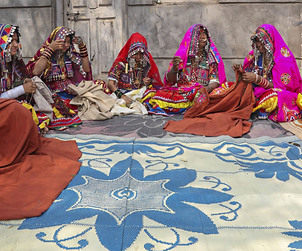Adorned in ivory bangles up to her arms and clothes with sparkling bits of mirror work, 30-year-old Sunanda Jadhav of the nomadic Lambani community in Karnataka’s Vijayapura carries off her traditional attire with grace and embroiders exquisite designs on fabric effortlessly.
Jhadav, a single mother to four young children, is among the 60 or so women working with Banjara Kasuti, an all-woman NGO working to revive the age-old textile art. Their lives and livelihoods, up until a few years ago, were hanging by a thread. Rampant poverty, alcoholic husbands, and the sword of migration—in search of back-breaking jobs in agriculture or construction—hang over their heads, but the Lambani community women of the nondescript village of Arakeri have recently found a new lease of life in the age-old art.
This year is ushering in new hope for them. Armed with confidence, skill, and some hard-earned money, these women are now weaving the threads to a brighter future for themselves and perhaps their dying traditional art. Not for nothing, a shy and quiet Jhadav, hesitant to take most questions, parrots the names of various geometric-pattern Lambani stitches — from ‘Kilan’, ‘Vella’ to ‘Pote’ and ‘Nakra’ — with great aplomb on cue.
Lambani art, for the uninitiated, is a form of textile embellishment practised by the Lambani, or Banjara community, a nomadic group inhabiting several states of India, including Rajasthan, Gujarat, and Karnataka. It involves an elaborate use of colourful threads, the stitching of mirrors, decorative beads, small cowrie shells, and even low denomination coins, as well as a rich array of stitch patterns on loosely woven fabric.
According to the 2011 Census, the population of Karnataka’s Lambani tribe, listed as a Scheduled Caste community, stood at about 12.68 lakh. The money they make, Rs 250 per day, might seem like loose change to city dwellers, but to these women, it means “financial independence” and “self-reliance”.
Asha Patil, who founded Banjara Kasuti in 2017 with Seema Kishore, said money in their pockets ensures that the women are no longer reliant on their husbands for their well-being. “Earlier, some of these women would embroider these Lamabani patches at home, and their husbands would sell them on beaches in Goa or flea markets in nearby towns. That way, the money always remained with the husbands.

















